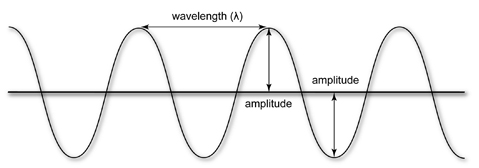Lessons Overview : Waves
Waves are fundamental to a study of science. This is because waves are constantly occurring in the natural world. The following characteristics of waves apply to all waves.Scientists often classify waves by their wavelength. One wavelength is the distance from one crest of a wave to the next crest of a wave (or the distance between two adjacent troughs).
The height of one crest (or the depth of one trough) from the center of the waveform is called the amplitude of the wave.

Waves in nature typically move over time. The time it takes a wave to make one complete cycle (from one crest to the next crest or one trough to the next trough) is called the period of the wave.
The frequency of a wave is the inverse of its period or the number of cycles the wave makes per second. For example, if a certain wave has a period of 5 seconds, its frequency is 1/5 cycles per second. The unit of one cycle per second is also known as one Hertz (Hz).
Wave velocity is the distance one crest (or trough) travels in a given amount of time. While this may sound similar to frequency, frequency is a number of cycles per second (Hz), while wave velocity is a distance per second (usually given in meters per second).